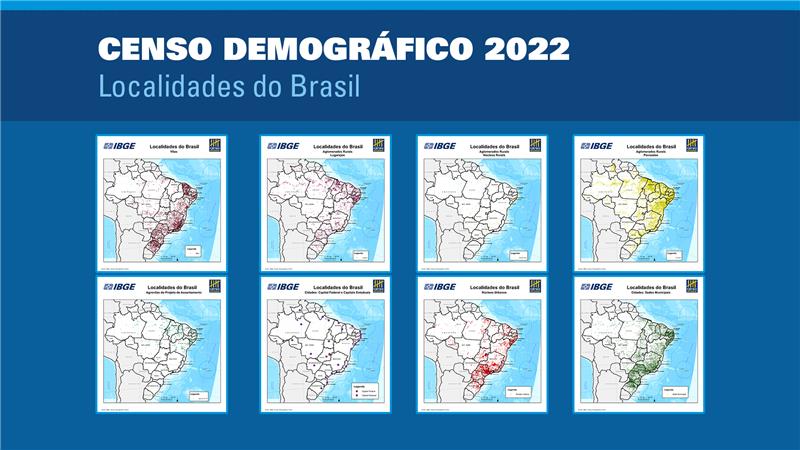Complete Life Tables
In 2023, life expectancy reaches 76.4 years; surpasses pre-pandemic level
November 29, 2024 10h00 AM | Last Updated: December 02, 2024 11h34 AM
Highlights
- Life expectancy increased by 11.3 months in 2023 in relation to 2022, hitting 76.4 years and surpassing the pre-pandemic level (76.2 years in 2019).
- Life expectancy of men was 73.1 years and, of women, 79.7 years.
- The infant mortality rate (those under 1 year) was 12.5 deaths for every thousand births, being 13.5 for men and 11.4 for women.
- The mortality rate in the childhood (those under 5 years) remained stable at 14.7 deaths in 2022 and 2023.
- In 2023, male over-mortality between 20 and 24 years was 4.1 times.
- In 2023, life expectancy at 60 years was 22.5 years for the entire population, being 20.7 years for men and 24.0 years for women.

A person born in Brazil in 2023 was expected to live, on average, up to 76.4 years, an increase of 11.3 months in relation to the previous year, surpassing the pre-pandemic level. The increase was of 12.4 months for the male population, changing from 72.1 years to 73.1 years. The gain was slightly smaller for women, changing from 78.8 years to 79.7 years (nearly 10.5 months).
This information is available in the Complete Life Tables for Brazil 2023, released today (29) by the IBGE, including life expectancies of exact ages up to 90 years of age, for Brazil. This information is used as one of the parameters to calculate the social security factor for retirement pensions under the General Social Security System.
"The rise in the number of deaths in Brazil and in the world with the Coronavirus pandemic reduced life expectancy at birth in 2020 and 2021, reaching 72.8 years in the latter (being 69.3 years for men and 76.4 years for women). The recovery of this indicator after 2022 reflects the reduction of the excess of deaths caused by the pandemic, for both sexes," notes Izabel Marri, IBGE´s Manager of Studies and Analyses of Demographic Dynamics.
Compared with the year of 1940, when life expectancy for both sexes was 45.5 years, it increased 30.9 years, being 30.2 years for men and 31.4 years for women.
| Life expectancy at birth - Brazil - 1940/2023 | ||||
|---|---|---|---|---|
| Year | Life expectancy at birth (years) | Difference between sexes (years) |
||
| Total | Man | Woman | ||
| 1940 | 45.5 | 42.9 | 48.3 | 5.4 |
| 1950 | 48.0 | 45.3 | 50.8 | 5.5 |
| 1960 | 52.5 | 49.7 | 55.5 | 5.8 |
| 1970 | 57.6 | 54.6 | 60.8 | 6.2 |
| 1980 | 62.5 | 59.6 | 65.7 | 6.1 |
| 1991 | 66.9 | 63.2 | 70.9 | 7.7 |
| 2000 | 71.1 | 67.3 | 75.1 | 7.8 |
| 2010 | 74.4 | 70.7 | 78.1 | 7.4 |
| 2019 | 76.2 | 72.8 | 79.6 | 6.8 |
| 2020 | 74.8 | 71.2 | 78.5 | 7.3 |
| 2021 | 72.8 | 69.3 | 76.4 | 7.1 |
| 2022 | 75.4 | 72.1 | 78.8 | 6.7 |
| 2023 | 76.4 | 73.1 | 79.7 | 6.6 |
| Change (1940/2023) | 30.9 | 30.2 | 31.4 | |
| Sources: 1940, 1950, 1960 and 1970 - Tables built under the Department of Studies and Analyses of Demographic Dynamics. 1980 and 1991 - ALBUQUERQUE, Fernando Roberto P. de C. and SENNA, Janaína R. Xavier “Tábuas de Mortalidade por Sexo e Grupos de Idade - Grandes e Unidades da Federação – 1980, 1991 e 2000. Textos para discussão, Diretoria de Pesquisas, IBGE, Rio de Janeiro, 2005.161p. ISSN 1518-675X; no. 20 2000 onwards - IBGE/Directorate of Surveys. Coordination of Population and Social Indicators. Department of Studies and Analyses of Demographic Dynamics. Projection of the Brazilian population by sex and age for the 2000-2070 period. |
||||
Infant mortality rate drops 91.5% between 1940 and 2023
In 2023, the probability of a newly born die before one year of age, that is, the infant mortality rate, was 12.5 deaths for every thousand births, being 13.5 for men and 11.4 for women. In 1940, the infant mortality rate was 146.6 deaths for every thousand live births, i.e., it registered a reduction of 91.5%.
The mortality of children under 5 years, or mortality in childhood, remained stable in the last two years of the time series. In 2022 and 2023, of every thousand live births, 14.7 did not complete 5 years of age. In 1940, this rate was 212.1, having reduced 93.1%. "In this age group, the intensity of mortality concentrates in the first year of life, representing 85% of the deaths in this range," explains the manager.
| Infant mortality rate (per thousand), mortality rate in the group between 1 and 4 years of age (per thousand) and mortality rate in childhood (per thousand) - Brazil - 1940/2023 | |||||
|---|---|---|---|---|---|
| Year | Infant mortality rate (per thousand) | Mortality rate in the group between 1 and 4 years of age (per thousand) |
Mortality rate in the childhood (per thousand) |
Chance to die of children who died before 5 years of age (%) | |
| Before 1 year of age | Between 1 and 4 years of age |
||||
| 1940 | 146.6 | 76.7 | 212.1 | 69.1 | 30.9 |
| 1950 | 136.2 | 65.4 | 192.7 | 70.7 | 29.3 |
| 1960 | 117.7 | 47.6 | 159.6 | 73.7 | 26.3 |
| 1970 | 97.6 | 31.7 | 126.2 | 77.3 | 22.7 |
| 1980 | 69.1 | 16.0 | 84.0 | 82.3 | 17.7 |
| 1991 | 45.1 | 13.1 | 57.6 | 78.3 | 21.7 |
| 2000 | 28.1 | 4.6 | 32.6 | 86.3 | 13.7 |
| 2010 | 15.0 | 2.5 | 17.5 | 85.8 | 14.2 |
| 2019 | 12.1 | 2.0 | 14.1 | 85.7 | 14.3 |
| 2020 | 11.4 | 1.6 | 13.0 | 87.8 | 12.3 |
| 2021 | 12.2 | 1.8 | 13.9 | 87.4 | 12.6 |
| 2022 | 12.4 | 2.3 | 14.7 | 84.7 | 15.3 |
| 2023 | 12.5 | 2.2 | 14.7 | 85.0 | 15.0 |
| % Change (1940/2023) | -91.5 | -97.1 | -93.1 | ||
| Change (1940/2023) | -134.1 | -74.5 | -197.4 | ||
| Sources: 1940, 1950, 1960 and 1970 - Tables built under the Department of Studies and Analyses of Demographic Dynamics. 1980 and 1991 - ALBUQUERQUE, Fernando Roberto P. de C. and SENNA, Janaína R. Xavier “Tábuas de Mortalidade por Sexo e Grupos de Idade - Grandes e Unidades da Federação – 1980, 1991 e 2000. Textos para discussão, Diretoria de Pesquisas, IBGE, Rio de Janeiro, 2005.161p. ISSN 1518-675X; no. 20 2000 onwards - IBGE/Directorate of Surveys. Coordination of Population and Social Indicators. Department of Studies and Analyses of Demographic Dynamics. Projection of the Brazilian population by sex and age for the 2000-2070 period. |
|||||
Between 20 and 24 years, men have 4.1 more chances of dying than women
In 2023, male over-mortality (ratio between male and female mortality rates) concentrated on the age groups called young adults, 15 to 19, 20 to 24 and 25 to 29 years, with values of 3.4, 4.1 and 3.5, respectively. In the group between 20 and 24 years, a man aged 20 years had 4.1 more chance of not completing 25 years than a woman in the same age group. This phenomenon can be explained by the higher incidence of deaths due to external or non-natural causes, which mostly hits the male population.
Moreover, it should be highlighted that male over-mortality stepped up from the 1980s onwards, when the Brazilian population became mostly urban and external or non-natural causes (homicides, suicides, traffic accidents, drownings, accidental falls, etc.) played an important role, negatively, on the age structure of the mortality rates, especially of the young male adults.
Between 1940 and 2023, female mortality also decreased within the fertile period (between 15 and 49 years of age). In 1940, from every hundred thousand live births, 77,777 began the reproductive period and, among them, 57,336 completed it. As for 2023, out of every hundred thousand live births, 98,426 reached 15 years of age and, among them, 94,416 completed it. In other words, the probability of a female newly born completing the fertile period in 1940, which was 573‰, changed to 944% in 2023. "With the generalized decrease of the mortality levels, it lies evident the importance of the role of fertility in the regulation of the Brazilian population volume, since most women who are born will begin and complete the reproductive period, thus having the opportunity to have all children they desire," highlights Marri.
Life expectancy of elderly persons increases by 9.3 years between 1940 and 2023
In 1940, when an individual reached 60 years, he/she expected to live, on average, more 13.2 years, 11.6 years in the case of men and 14.5 years, in the case of women. Life expectancy at 60 was 22.5 years for the total population in 2023. Life expectancy at this age for men was 20.7 years and for women, 24.0 years. Effects of the COVID-19 pandemic were also reflected in this indicator, especially in 2020 and 2021, with a recovery from 2022 onwards.
Life expectancy when hitting 80 years was of 8.9 years in 2023, being 9.4 years for women and 8.3 years for men. In 1940, these values were 4.5 years for women and 4.0 years for men, indicating a higher increase in lifespan of the female population in relation to the male one. The difference by sex among life expectancies, which was of half year in 1940 in favor of women, changed to 1.2 years.
More about the survey
Life Tables 2023 come from the projection of the Brazilian population for the period between 2000 and 2070. Life Tables allow to know mortality patterns and levels of the Brazilian population and they have been used as one of the parameters required to calculate the social security factor for the retirement pensions of the General Social Security System.

















